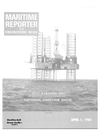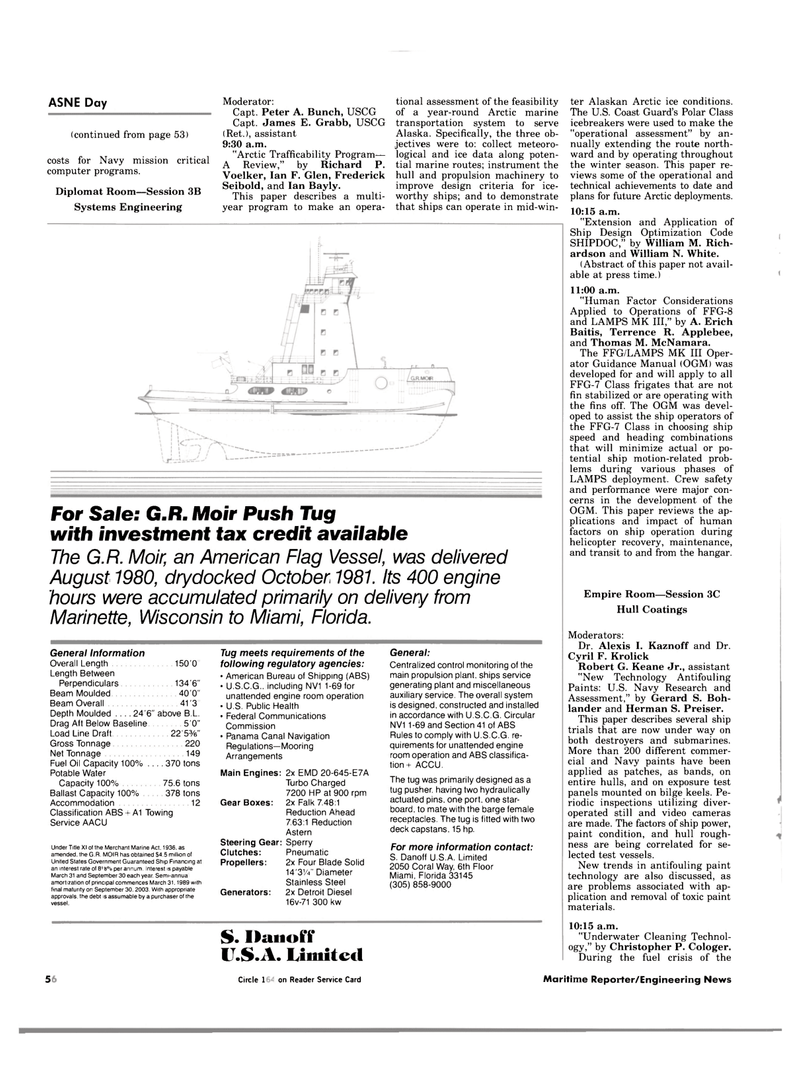
Page 52: of Maritime Reporter Magazine (April 1984)
Read this page in Pdf, Flash or Html5 edition of April 1984 Maritime Reporter Magazine
ASNE Day (continued from page 53) costs for Navy mission computer programs. critical
Diplomat Room—Session 3B
Systems Engineering
Moderator:
Capt. Peter A. Bunch, USCG
Capt. James E. Grabb, USCG (Ret.), assistant 9:30 a.m. "Arctic Trafficability Program—
A Review," by Richard P.
Voelker, Ian F. Glen, Frederick
Seibold, and Ian Bayly.
This paper describes a multi- year program to make an opera- tional assessment of the feasibility of a year-round Arctic marine transportation system to serve
Alaska. Specifically, the three ob- jectives were to: collect meteoro- logical and ice data along poten- tial marine routes; instrument the hull and propulsion machinery to improve design criteria for ice- worthy ships; and to demonstrate that ships can operate in mid-win-
For Sale: G.R. Moir Push Tug with investment tax credit available
The G.R. Moir, an American Flag Vessel, was delivered
August 1980, drydocked October 1981. Its 400 engine hours were accumulated primarily on delivery from
Marinette, Wisconsin to Miami, Florida.
General Information
Overall Length 150 0
Length Between
Perpendiculars 134'6"
Beam Moulded 40 0"
Beam Overall 1 3
Depth Moulded 24'6" above B.L.
Drag Aft Below Baseline 5'0"
Load Line Draft 22'5%
Gross Tonnage 220
Net Tonnage 149
Fuel Oil Capacity 100% 370 tons
Potable Water
Capacity 100% 75.6 tons
Ballast Capacity 100% 378 tons
Accommodation 12
Classification ABS + A1 Towing
Service AACU
Under Title XI of the Merchant Marine Act, 1936, as amended, the G.R. MOIR has obtained $4 5 million of
United States Government Guaranteed Ship Financing at an interest rate ol 81 per annum. Interest is payable
March 31 and September 30 each year. Semi-annua amortization of principal commences March 31.1989 with final maturity on September 30. 2003. With appropriate approvals, the debt is assumable by a purchaser of the vessel.
Tug meets requirements of the following regulatory agencies: • American Bureau of Shipping (ABS) • U.S.C.G.. including NV1 1-69 for unattended engine room operation • U.S. Public Health • Federal Communications
Commission • Panama Canal Navigation
Regulations—Mooring
Arrangements
Main Engines:
Gear Boxes:
Steering Gear:
Clutches:
Propellers:
Generators: 2x EMD 20-645-E7A
Turbo Charged 7200 HP at 900 rpm 2x Falk 7.48:1
Reduction Ahead 7.63:1 Reduction
Astern
Sperry
Pneumatic 2x Four Blade Solid 14'31/)" Diameter
Stainless Steel 2x Detroit Diesel 16v-71 300 kw
General:
Centralized control monitoring of the main propulsion plant, ships service generating plant and miscellaneous auxiliary service. The overall system is designed, constructed and installed in accordance with U.S.C.G. Circular
NV1 1-69 and Section 41 of ABS
Rules to comply with U.S.C.G. re- quirements for unattended engine room operation and ABS classifica- tion + ACCU.
The tug was primarily designed as a tug pusher, having two hydraulically actuated pins, one port, one star- board. to mate with the barge female receptacles. The tug is fitted with two deck capstans. 15 hp.
For more information contact:
S. Danoff U.S.A. Limited 2050 Coral Way, 6th Floor
Miami, Florida 33145 (305) 858-9000
S. I)auoft'
U.S.A. Limited ter Alaskan Arctic ice conditions.
The U.S. Coast Guard's Polar Class icebreakers were used to make the "operational assessment" by an- nually extending the route north- ward and by operating throughout the winter season. This paper re- views some of the operational and technical achievements to date and plans for future Arctic deployments. 10:15 a.m. "Extension and Application of
Ship Design Optimization Code
SHIPDOC," by William M. Rich- ardson and William N. White. (Abstract of this paper not avail- able at press time.) 11:00 a.m. "Human Factor Considerations
Applied to Operations of FFG-8 and LAMPS MK III," by A. Erich
Baitis, Terrence R. Applebee, and Thomas M. McNamara.
The FFG/LAMPS MK III Oper- ator Guidance Manual (OGM) was developed for and will apply to all
FFG-7 Class frigates that are not fin stabilized or are operating with the fins off. The OGM was devel- oped to assist the ship operators of the FFG-7 Class in choosing ship speed and heading combinations that will minimize actual or po- tential ship motion-related prob- lems during various phases of
LAMPS deployment. Crew safety and performance were major con- cerns in the development of the
OGM. This paper reviews the ap- plications and impact of human factors on ship operation during helicopter recovery, maintenance, and transit to and from the hangar.
Empire Room—Session 3C
Hull Coatings
Moderators:
Dr. Alexis I. Kaznoff and Dr.
Cyril F. Krolick
Robert G. Keane Jr., assistant "New Technology Antifouling
Paints: U.S. Navy Research and
Assessment," by Gerard S. Boh- lander and Herman S. Preiser.
This paper describes several ship trials that are now under way on both destroyers and submarines.
More than 200 different commer- cial and Navy paints have been applied as patches, as bands, on entire hulls, and on exposure test panels mounted on bilge keels. Pe- riodic inspections utilizing diver- operated still and video cameras are made. The factors of ship power, paint condition, and hull rough- ness are being correlated for se- lected test vessels.
New trends in antifouling paint technology are also discussed, as are problems associated with ap- plication and removal of toxic paint materials. 10:15 a.m. "Underwater Cleaning Technol- ogy," by Christopher P. Cologer.
During the fuel crisis of the 52 Circle 159 on Reader Service Card Maritime Reporter/Engineering News

 51
51

 53
53
